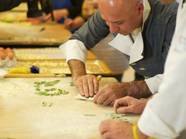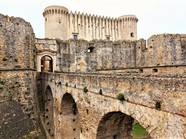The Unfortunate Pilgrim
Every October, or “Italian Heritage and Culture Month” as it known in La Grande Mela, I have mixed feelings. Few count me as Italian American despite treasuring my mysterious patrimony, including the fact that all Italians are anarchists until they are in charge.
Despite having been a Founder of the American Italian Coalition of Organizations, and President
of the American Italian Historical Association, I never apply for anything with “Italian” or “American Studies” in the title. As to “onlyreal Italians need apply” I’ve had too manybad experiences.
For example, when I was Director of the Brooklyn College Center for Italian American Studies (1975-1984) several “real” Italian American professors complain ed that a “non-Italian” held the post.
My researchon Italian American college students helpedestablish the Distinguished Professorship ofItalian American Studies. However, whensomeone mistakenly nominated me for thepost, I received a call from a prominent ItalianAmerican starting with “How dare you….”My identity problem has a long history. When I started dating my wife Suzanne Nicolettiin 1958, her parents wanted to know my“nationality.” As I didn’t know I looked throughsome family papers and discovered that mymother’s maiden name was “Cangelosi.”When I asked her why never told us she wasItalian she replied, “We’re not,” explaining thather mother said they were “Sicilian.”
I thoughtthis was a positive, so I told Suzanne the “goodnews,” which for her un-Sicilian parents wasrather bad. Most of her relatives still think I’mIrish because most of the “mixed marriages”they know of are Irish-Italian.Three decades later, I got a PSC/CUNY grantto do “Photographic Research in SouthernItaly.” Suzanne’s relatives encouraged us tovisit their hometown in Laurino, Province of Salerno.
A borrowed Italian Auto Club road map showed a direct route from Potenzato Laurino on an ominously colored Strada Provinciale (county road) 11e and 11f. As Idrove I asked pedestrians along the way “È questa strada per Laurino?” But the responseswere incomprehensible: “Si, ma bla, bla, bla,bla.” (“Is this the road to Laurino? Yes, but blah, blah, blah, blah”).
The road morphedfrom two paved lanes, to two unpavedlanes, to one unimproved lane where weencountered goats and herders. After severalhours of breath-taking views and backbreakingbumps the roadway improved andwe entered Laurino.
We asked people for the residence of lafamiglia De Gregorio and were energeticallypointed the way to a three-story stuccoedbuilding situated on a steep incline wherewe knocked on the door. The small, yetthree-generation, extended family was justfinishing dinner. When we explained who wewere, they treated us like lost, royal, relatives.The table was quickly re-set and after wefinished eating and drinking we were invitedto stay longer (even a few days).
We thankedthem for their kind invitation but explainedwe were on our way to meet people inSorrento and needed to make up for the timelost in the mountains. The men took us to abar and introduced to neighbors and friends.There were some tears when we left and wefelt as though we were leaving “home”, butunderstood our real home was in Brooklyn. Back in “The States,” I decided to explore the“conversation” I had with people along Strada provinciale 11 to Laurino. I sent the e-mailmessage below to some of my academicItalian friends.
Their responses reveal a greatdeal about authentic Italian bontà: Amici/eI need help with a translation of phrase from English into Italian for a paper I am writingabout my own, and my wife Suzanne’s,search for our roots in Italy.
It regardstraveling to a remote village in Campania(Italy) and asking people along the waywhether this was the road to the town. Thequestion I asked, perhaps incorrectly, was:“E’ questa la strada per Laurino?” The answerin Italian was (credo): “Yes, but you can’t getthere from here.”; “Yes, but you can’t getthere this way.”; or “Yes, but the road turnsinto a goat path” (which it did). Grazie tante, Mino Cangelosi Krase.
These were the replies:1. “Sì, ma non ci arriva da quì; Sì, ma non è questala strada; Sì, ma la strada diventa una strada dacapre.” Hope to see you soon. All the best MinoVianello.2. Traduzione: “E’ questa la strada per Laurino?Sì, ma non ci si arriva da qui. La strada diventauna mulattiera (mule trail).” Saluti, MaddalenaTirabassi.3. “Sì, ma non ci si arriva da qui; Sì, ma la stradava a finire in un sentiero (but I would not knowhow to translate ‘goat path.’)” Best, CristinaAllemann-Ghionda.4.
Dear Jerry: My translation: “Sì, ma non ci siarriva da qui; Sì, ma non ci si arriva da questaparte; “Sì, ma la strada diventa una mulattiera.”Best, Stefano Luconi.5. Jerry, I am on my way to Venice for aMA thesis discussion where I acted as cosupervisor.“Si, ma non puoi/può andarci daqui...” Will get back to you soon again, best!Paolo Ruspini.6. The most Italianate response, which Igratefully received from my Italian colleagueswas as follows:Jerry: the question “E’ questa la strada perLaurino?” is perfect, in Italian. The problemis that, encountering a “native” in Italy, thenative — only to be kind — tends to reply to thequestion as if it were: “Is this the one best wayto Laurino?”; so that the reply is: “Ok, this wayis good, inasmuch as it goes to Laurino; the bestway, however, is ...” In fact, replying: “No, it’swrong, the good way is another one” the nativecould have felt uneasy, since the reply would bea bit rude. Anyway: your question was classical;I also would have used the same linguisticform; and I would have had the same reaction. Bye.
Leonardo Cannavo.I replied to Leonard, thusly: grazie tante, macome si dice in italiano le frase? How would yousay it in Italian? And can I quote you in mypaper? I think your understanding of thesituation is perfect. La tua comprensione dellasituazione è perfetta!To which he wrote:Ok, sorry, I didn’t get the point. The easiesttranslations for the three phrases is asfollows:“Yes, but you can’t get there from here” = “Sì,ma da qui non ci può arrivare.”“Yes, but you can’t get there this way” = “Sì,ma da questa strada non ci può arrivare.”“Yes, but the road turns into a goat path” = “Sì,ma la strada diventa un sentiero per capre.”If you quote me in a paper of yours, it will bean honor; you need not ask for permission.
Most unfortunately, few methodologists (andconsider that I feel uneasy wearing the hatof a methodologist) refuse to consider thecultural and psychosocial frames of theirjob. Speech interaction is both amusing andrevealing. Bye. L. As a child, I had attended a few Italian“football” weddings, and as an adult I went toa rather unsatisfying Cangelosi reunion, morelike a picnic, in Garfield, New Jersey. I hopedthe Cangelosi clan gathering would be like theSicilian wedding scene from the Godfather,Part II.
For people like me expectations or“demands” for authentic experiences can’tbe met because we never experienced them.We move through the scenes but have neverbeen, and will never be, part of them. To beAmerican is to be uprooted, if not rootless,in the sense of having roots elsewhere, andour journey in search of our imaginary Italianhome made that clear. In searching formy roots I became an unfortunate pilgrim,because in the final analysis “You can’t getthere from here.”


































i-Italy
Facebook
Google+
This work may not be reproduced, in whole or in part, without prior written permission.
Questo lavoro non può essere riprodotto, in tutto o in parte, senza permesso scritto.